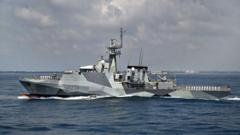As South Korea protests China's installations deemed threats, dual-use concerns echo past disputes in regional waters.
China's Controversial Sea Installations Raise Concerns in South Korea

China's Controversial Sea Installations Raise Concerns in South Korea
China's newly placed structures in the Yellow Sea are suspected by South Korea to serve military purposes, intensifying diplomatic tensions.
In recent years, China has deployed a decommissioned offshore oil-drilling rig along with two massive octagonal steel cages into the Yellow Sea, a region shared with South Korea. While China claims these installations function as deep-sea fish farms, South Korean officials express alarm, suspecting they serve a potential military application.
South Korea's National Assembly took a formal stance against the Chinese constructions on Monday, with its ocean and fisheries committee issuing a resolution condemning these structures as “a threat to maritime safety,” a sentiment that garnered bipartisan support. This apprehension was further fueled by a report from the Center for Strategic and International Studies based in Washington. This analysis, which utilized satellite images, indicated that even if the primary focus of the platforms is aquaculture, the possibility of dual-use—meaning potential military applications—cannot be entirely dismissed due to China's historical actions in the South China Sea.
The report highlighted that these platforms might already be gathering data useful for undersea navigation and surveillance. South Koreans recall the evolution of Chinese activities in the South China Sea, where initial civilian-related projects morphed into military bases, igniting territorial disputes with nations such as the Philippines and Vietnam.
The situation concerning the Chinese structures in the Yellow Sea will likely represent a significant foreign policy challenge for President Lee Jae Myung, who began his term earlier this month. While he is advocating for enhanced relationships with Beijing, he simultaneously commits to bolstering South Korea's alliance with the United States. President Lee anticipates meeting Chinese leader Xi Jinping during the upcoming Asia-Pacific Economic Cooperation summit in Gyeongju, South Korea, this November.
South Korea's National Assembly took a formal stance against the Chinese constructions on Monday, with its ocean and fisheries committee issuing a resolution condemning these structures as “a threat to maritime safety,” a sentiment that garnered bipartisan support. This apprehension was further fueled by a report from the Center for Strategic and International Studies based in Washington. This analysis, which utilized satellite images, indicated that even if the primary focus of the platforms is aquaculture, the possibility of dual-use—meaning potential military applications—cannot be entirely dismissed due to China's historical actions in the South China Sea.
The report highlighted that these platforms might already be gathering data useful for undersea navigation and surveillance. South Koreans recall the evolution of Chinese activities in the South China Sea, where initial civilian-related projects morphed into military bases, igniting territorial disputes with nations such as the Philippines and Vietnam.
The situation concerning the Chinese structures in the Yellow Sea will likely represent a significant foreign policy challenge for President Lee Jae Myung, who began his term earlier this month. While he is advocating for enhanced relationships with Beijing, he simultaneously commits to bolstering South Korea's alliance with the United States. President Lee anticipates meeting Chinese leader Xi Jinping during the upcoming Asia-Pacific Economic Cooperation summit in Gyeongju, South Korea, this November.





















